Description
Radian Barite aka Radio Baryte (Ba,Ra)SO₄ [with Rn]
You can almost see this rock breathing if you hold a geiger counter to it, and this Radian Barite is an example of why some of your fireworks may be radioactive! Barite/Baryte is used for the green color it produces, and radium sometimes replaces the barium, as in this rock. Don’t let kids play with this rock, and don’t keep this near your bed or food or in your bedroom without proper protections in place and the knowledge on how to handle this safely.
This rock is possibly the most radioactive rock at ColoRockCo. Not consistently, 24/7/365, but Samarskite and Uraninite don’t breathe Radon gas to the same extent as does this rock. According to Wikipedia, you definitely don’t want to ingest this element, but “as of 2015, 226Ra is considered to be the most toxic of the quantity radioelements, and it must be handled in tight glove boxes with significant airstream circulation that is then treated to avoid escape of its daughter 222Rn to the environment.”
Barite/Baryte in general is found almost everywhere with 13,704 recorded localities on mindat in a variety of rocks and formations, although, few Barite/Baryte specimens are known to have been recognized as radioactive after being replaced with Radium. Barite/Baryte comes from the Greek, βαρύς, romanized as barús, meaning ‘heavy’. Most Barite is mined to be used in the Oil and Natural Gas industries as an additive in drilling mud to make it heavier and prevent blowouts, and as mentioned above, in Fireworks.
Radium is a short-lived radioactive element, so it’s quite curious and interesting as to how this exact rock came to be… Was it Uraninite within the last 1,600 years? The naming of radium dates to about 1899, from the French word radium, formed in Modern Latin from radius (ray): this was in recognition of radium’s power of emitting energy in the form of rays. Radium was used in paint due to its ability to glow in the dark. But, not anymore, thankfully, as it’s quite toxic. Further down in that Wikipedia article, it mentions another instance where “the French physicist Antoine Becquerel carried a small ampoule of radium in his waistcoat pocket for six hours and reported that his skin became ulcerated.”
It’s definitely worth reading the rest of the https://en.wikipedia.org/wiki/Radium page, but from the History section: Radium was discovered by Marie Skłodowska-Curie and her husband Pierre Curie on 21 December 1898, in a uraninite (pitchblende) sample from Jáchymov. While studying the mineral earlier, the Curies removed uranium from it and found that the remaining material was still radioactive. In July 1898, while studying pitchblende, they isolated an element similar to bismuth, which turned out to be polonium. They then isolated a radioactive mixture consisting of two components: compounds of barium, which gave a brilliant green flame color, and unknown radioactive compounds, which gave carmine spectral lines that had never been documented before. The Curies found the radioactive compounds to be very similar to the barium compounds, except they were less soluble. This discovery made it possible for the Curies to isolate the radioactive compounds and discover a new element in them. The Curies announced their discovery to the French Academy of Sciences on 26 December 1898. In September 1910, Marie Curie and André-Louis Debierne announced that they had isolated radium as a pure metal through the electrolysis of pure radium chloride (RaCl2) solution using a mercury cathode, producing radium–mercury amalgam. This amalgam was then heated in an atmosphere of hydrogen gas to remove the mercury, leaving pure radium metal. Later that same year, E. Eoler isolated radium by thermal decomposition of its azide, Ra(N3)2. Radium metal was first industrially produced at the beginning of the 20th century by Biraco, a subsidiary company of Union Minière du Haut Katanga (UMHK) in its Olen plant in Belgium. The general historical unit for radioactivity, the curie, is based on the radioactivity of 226Ra.











Reviews
There are no reviews yet.